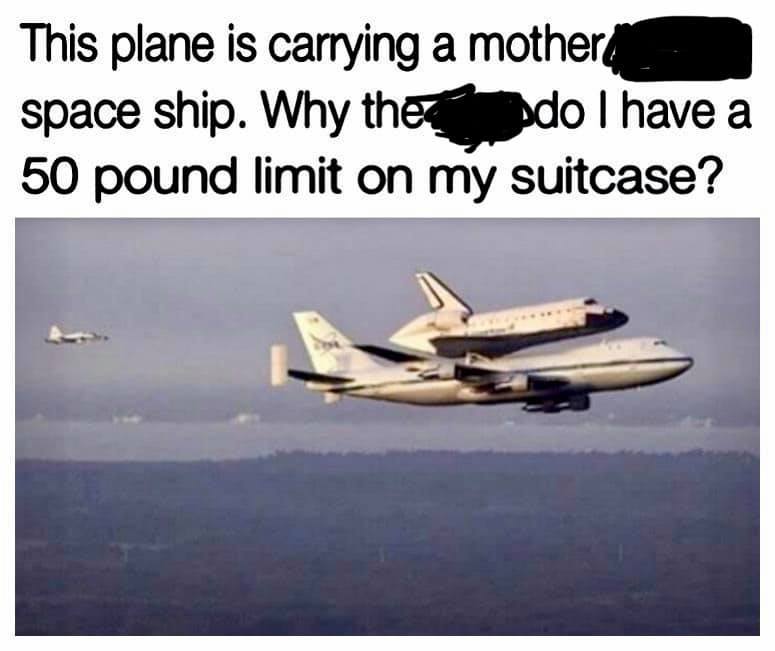While airline after airline has been retiring their supplies of Boeing 747 jumbo jets over the past few years, it reminds me of the time in aviation history when a Queen of the Skies owned by NASA was used to ferry space shuttles during the late 20th and early 21st centuries.
The Shuttle Carrier Program: A Unique Chapter in Aviation History
Back then, shuttle takeoffs and landings happened with relative frequency. But as amazing as those space shuttle missions were, they couldn’t really fly themselves since they were more gliders than planes. So 747s were used to bring the shuttles from wherever they landed (usually Edwards Air Force Base, in Southern California) back to Kennedy Space Center on the east coast of Central Florida so they could be prepared and sent back into space.
NASA’s Boeing 747s: Not Your Ordinary Jumbo Jets
This has been the running joke in recent years about the weight the plane must have carried with a space shuttle on its back.

But the meme brings up a very good point – how DID they get an ordinary 747 able to ferry a shuttle? Welp, it turns out those were no ordinary 747s. And yep, that’s plural – there were 2 of them. A Boeing 747-123 model (called NASA 905) was used through 1990, and then a Boeing 747-100SR-46 version (called NASA 911) did the work until the program ended (Psst! Here’s how to tell the difference between a Boeing and an Airbus).
Modifying the 747: Engineering Feats for Space Shuttle Transport
The skin of a plane is structurally made to withstand the pressure of flying at several tens of thousands of feet. However, having a space shuttle on its back was a whole other ballgame. So the two 747s were, not surprisingly, modified quite a bit, thanks to the work and calculations of aeronautical engineers.
Attachment points were built into the 747 to accommodate the shuttle’s weight and movement. Most seats in the cabin were removed (the first-class seats remained for NASA passengers), the main cabin was stripped, and the fuselage was strengthened. The shuttle riding on the plane’s back messed up the plane’s center of gravity, so vertical stabilizers were added to the plane’s tail for when the orbiters were being carried. The electrical systems and engines were also upgraded.
The Price of Transport: Fuel and Flight Limitations
Once all the modifications were made, the setup was similar to any plane carrying cargo – except that the cargo was outside instead of inside, and the value of the cargo was a couple of billion dollars. 😉
Airlines have come up with all kinds of crazy ways to decrease their planes’ weight to help lower fuel costs, but you can’t do that with a plane with a 165,000-pound space shuttle on its back. So, the 747 used much more fuel than it would sans orbiter. It could only fly about 1,200 miles before needing to refuel (without the shuttle, a 747 could go 6,300 miles), and could only fly up to about 15,000 feet altitude, with a maximum cruise speed of Mach 0.6 when the shuttle was attached.
Where Are They Now? The Legacy of NASA’s Shuttle Carrier Aircraft
The shuttle carrier program ran from the mid-1970s until the early 2010s. Both planes are on display for the public to see. N905 is at Space Center Houston with a mockup shuttle Independence mounted on its back. N911 can be found at the Joe Davies Heritage Airpark in Palmdale, California.
Click here for more specs and information about the shuttle carrier aircraft. Here’s a video of the N905 landing with Space Shuttle Endeavor at LAX.
Want to comment on this post? Great! Read this first to help ensure it gets approved.
Want to sponsor a post, write something for Your Mileage May Vary or put ads on our site? Click here for more info.
Like this post? Please share it! We have plenty more just like it and would love it if you decided to hang around and sign up to get emailed notifications of when we post.
Whether you’ve read our articles before or this is the first time you’re stopping by, we’re really glad you’re here and hope you come back to visit again!
This post first appeared on Your Mileage May Vary

2 comments
How Did A Boeing 747 Carry The Space Shuttle?
Very carefully.
Ba-dum-Tssss….